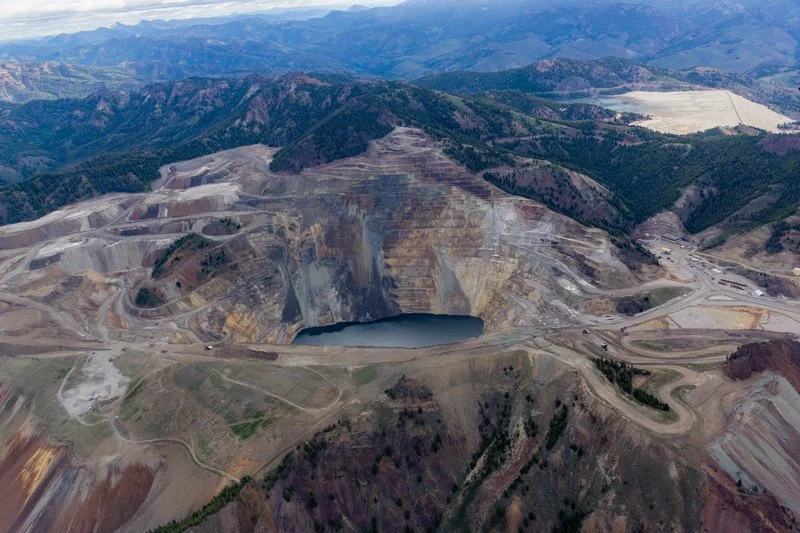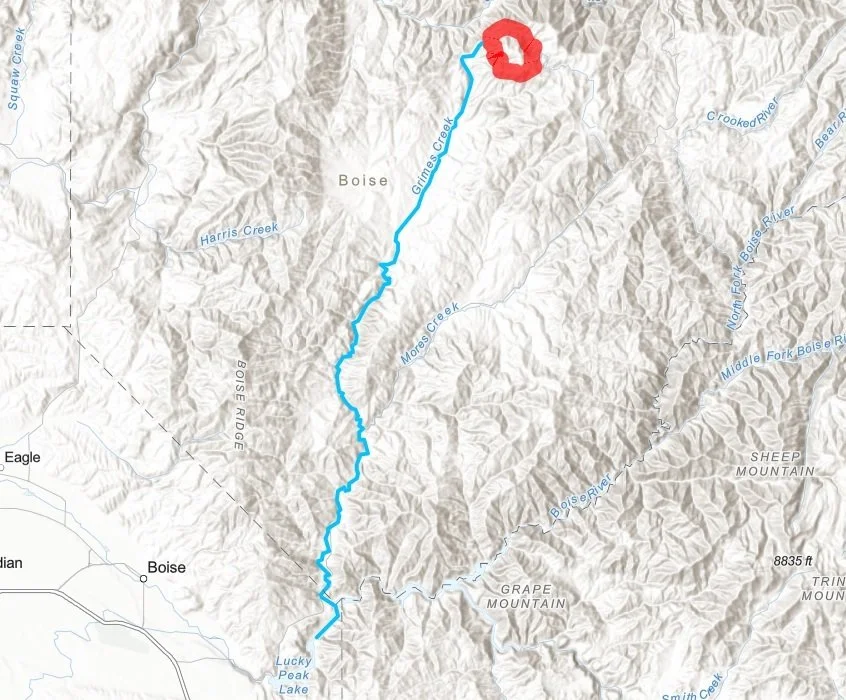CuMo mine exploration project update
An aerial view of Thompson Creek Mine. Photo credit: EcoFlight
The Canadian mining company, American CuMo, is making a third bid at permitting related to their molybdenum and copper claims in the headwaters of Grimes Creek, a major tributary of the Boise River. At this stage, the company is applying for an exploration permit to obtain a detailed assessment of its claims in order to justify their plan to develop one of the largest open-pit mines in the world.
Many of our members may be familiar with this project as it has been a high priority for us and our partners for over a decade. Multiple comment periods, open houses, and lawsuits have brought us to where we are today. For anyone who isn’t familiar with this project, here is a quick overview of the history and timeline.
Early in 2011, the Forest Service released its initial report analyzing the Plan of Operations that Mosquito Consolidated Gold Corp. (now Idaho CuMo Mining Corporation or ICMC) submitted to conduct extensive exploratory drilling at the CuMo project site at the headwaters of Grimes Creek.
View of the CuMu site looking north over Grimes pass towards the South Fork Payette River Canyon. Photo courtesy of EcoFlight.
The plan called to utilize existing roads that had been constructed during previous exploration efforts and to construct over 13 miles of new temporary access roads to obtain a more detailed site assessment. The plan called for 122 drill sites where more than 250 individual core samples would be drilled, up to 3,000 feet deep. Drilling would be conducted on a 24-hour schedule during the operating season of April 15th to December 15th, over a five year period followed by at least a two-year period for reclamation activity.
Following the release of this initial Environmental Assessment, Idaho Rivers United joined Idaho Conservation League and Golden Eagle Audubon Society in litigation challenging the analysis. Represented by Advocates for the West and Western Mining Action Network, the courts upheld the challenge that the Forest Service did not adequately analyze potential impacts to groundwater that may result from the large volume of deep drilling sites and requested that this issue be addressed, resulting in a Supplemental Environmental Assessment.
This Supplemental Environmental Assessment and associated analysis were released and signed in 2015. This revised analysis was again challenged by our coalition and once again the courts found that the Forest Service had acted improperly in their analysis of this project. However, this time the courts found the groundwater analysis to be satisfactory but impacts on Sacajawea’s Bitterroot, a rare plant found only in this region, was lacking. Additionally, the data that was presented was out of date based on the 2014 Grimes Fire that impacted the project site.
Again, the Forest Service returned to their analysis, focusing on the impacts to this rare plant species. Surveys and baseline condition studies were completed in 2016. Unfortunately following the completion of these studies, the Pioneer Fire again burned a significant portion of the project area requiring the Forest Service to reevaluate the conditions on the ground for this rare plant species. These studies were initiated in 2018 after the Forest Service announced the most recent round of scoping for this project.
Since 2018, this project has been relatively quiet but we have been told to expect the publication of the most recent Environmental Assessment sometime in the near future.
Although this project is still in its infancy, it nonetheless has been the source of some very loud opposition. Situated at the headwaters of one of the Boise River’s main tributaries, one of our primary concerns is that if this project moves forward, the entire basin would be at risk of contamination from any issues that may arise at the project site.
From the project site, any spill or contamination will make its way down Grimes Creek, into Mores Creek, and eventually the Boise River via Lucky Peak Reservoir. Given that the Boise River provides more than 20% of the city’s drinking water, there is reason to be cautious about rushing head first into this potentially massive open-pit mine.
Image of the project site and drainage path down Grimes Creek towards Lucky Peak Reservoir.
Recreation and fisheries are also areas of concern as we’ve continued to monitor this project. The surrounding watershed provides habitat for bull trout and native redband trout. With the likely increase in sedimentation, fish populations within and downstream of the project area may feel the impacts from increased traffic and sedimentation.
Directly to the north of the CuMo site lies the South Fork Payette River, eligible to be protected under the Wild and Scenic Rivers Act. Under the proposed plan, the scenic values that make the South Fork eligible would be impacted as the mine site’s new access roads and associated construction would be visible from the river corridor near Danskin. If the mine were to move forward, the impacts would be a stark difference from the amazing scenery that the South Fork is currently known for.
Additionally, Idaho already has one massive open-pit molybdenum mine. Located between Stanley and Challis, the Thompson Creek mine is already permitted to extract the same resources that the CuMo project has targeted.
Highlighting the volatility of mineral prices and the impact these fluctuations have on industrial mines, Thompson Creek mine was placed on ‘care and maintenance’ in December in 2014, essentially putting the entire mine on hold until prices improve and operations again become economical.
Given the potential risks that the CuMo mine poses to the Boise River and all that it provides for our community and the fact that Idaho already has one massive open-pit molybdenum mine, IRU will continue to represent our members and fight to stop this risky and unnecessary project and will be sure to let you know of how to get involved and have your voice heard as this project moves forward.




